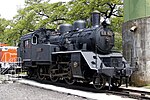
A Mallet locomotive is a type of compound articulated steam locomotive, invented by the Swiss engineer Anatole Mallet (1837–1919).

0-6-0 is the Whyte notation designation for steam locomotives with a wheel arrangement of no leading wheels, six powered and coupled driving wheels on three axles, and no trailing wheels. Historically, this was the most common wheel arrangement used on both tender and tank locomotives in versions with both inside and outside cylinders.

In the Whyte notation for the classification of steam locomotives by wheel arrangement, a 2-8-8-0 is a locomotive with a two-wheel leading truck, two sets of eight driving wheels, and no trailing truck.
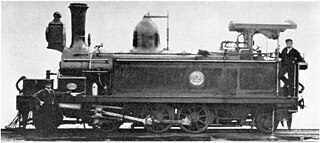
Under the Whyte notation for the classification of steam locomotives, 2-6-2 represents the wheel arrangement of two leading wheels, six coupled driving wheels and two trailing wheels. This arrangement is commonly called a Prairie.
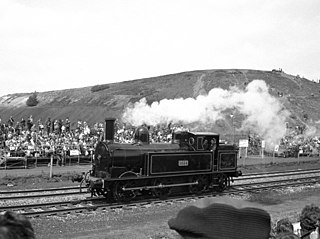
Under the Whyte notation for the classification of steam locomotives, 0-6-2 represents the wheel arrangement of no leading wheels, six powered and coupled driving wheels on three axles and two trailing wheels on one axle.
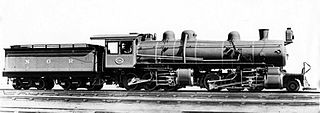
Under the Whyte notation for the classification of steam locomotives by wheel arrangement, 2-6-6-0 is a locomotive with one pair of unpowered leading wheels, followed by two sets of three pairs of powered driving wheels and no trailing wheels. The wheel arrangement was principally used on Mallet-type articulated locomotives. Some tank locomotive examples were also built, for which various suffixes to indicate the type of tank would be added to the wheel arrangement, for example 2-6-6-0T for an engine with side-tanks.

In Whyte notation for the classification of steam locomotives by wheel arrangement, an 0-4-4-2 is a locomotive that has no leading wheels, two sets of four driving wheels and two trailing wheels.

The Class D51 (D51形) is a type of 2-8-2 steam locomotive built by the Japanese Government Railways (JGR), the Japanese National Railways (JNR), and Kawasaki Heavy Industries Rolling Stock Company, Kisha Seizo, Hitachi, Nippon Sharyo, Mitsubishi, and Mitsubishi Heavy Industries from 1936 to 1945 and 1950 to 1951. 174 were preserved in Japan but 5 out of the 174 are operational leaving only 169 on display.

The Cepu Forest Railway is a 1,067 mm narrow gauge light logging railway that runs through teak plantations to the northwest of the town of Cepu, in Cepu district, on the boundary between Central and East Java provinces, on the island of Java in Indonesia. It is owned by Perhutani, a state-owned forestry company of Indonesia. Steam traction is still dominant.

The Mooka Line is a Japanese railway line connecting Shimodate Station, in Chikusei, Ibaraki and Motegi Station in Motegi, Tochigi. It is the only railway line operated by the Mooka Railway. The third sector company took over the former JR East line in 1988. In addition to regular diesel local trains, the line also operates the SL Mooka steam service for tourists using C11 and C12 class steam locomotives.
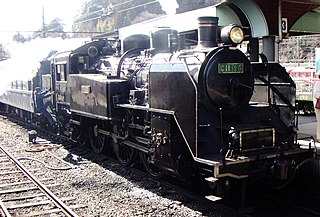
The Ōigawa Main Line is a Japanese railway line which connects Kanaya Station in Shimada, Shizuoka Prefecture with Senzu Station in Kawanehon, Haibara District, Shizuoka Prefecture. It is owned and operated by the private railway operator Ōigawa Railway.

The Ambarawa Railway Museum is a museum located in Ambarawa in Central Java, Indonesia. The museum preserves around 21 steam locomotives and focuses on tourism train tours hauled by 3 operational steam engines and a hydraulic diesel engine, using the remains of the closing of the 3 ft 6 in (1,067 mm) railway line.

The Kamaishi Line is a 90.2 km (56.0 mi) rural railway line in Iwate Prefecture, Japan, operated by the East Japan Railway Company. It connects Hanamaki Station in the city of Hanamaki with Kamaishi Station in the city of Kamaishi.

The Class C58 is a 2-6-2 wheel arrangement steam locomotive type built by the Japanese Government Railways (JGR) and Japanese National Railways (JNR) from 1938 to 1947. A total of 427 Class C58 locomotives were built and designed by Hideo Shima. Two members of the class are preserved in working order.

The Class C56 is a type of 2-6-0 steam locomotive built by the Japanese Government Railways (JGR) from 1935 to 1939, and later operated by Japanese National Railways (JNR). They were numbered C56 1-C56 164 a total of 164 were built from 1935 to 1939 locomotives numbered C56 1-C56 90 and C56 161-C56 164 were sent to other countries in Asia during the Second World War. The locomotives were retired in 1974. They were designed by Hideo Shima.

The Class C10 is a type of 2-6-4T steam locomotive built by the Japanese Government Railways from 1930. A total of 23 Class C10 locomotives were built and designed by Hideo Shima. They were numbered C10 01-C10 23. They were operated until 1962. Only one member of the Class is preserved which is C10 8. It is preserved on the Ōigawa Railway. They would later form the basis of the JNR Class C11 in 1932.

The Class C11 (C11形) is a type of 2-6-4T steam locomotive built by the Japanese Government Railways and the Japanese National Railways from 1932 to 1947. A total of 381 Class C11 locomotives were built and designed by Hideo Shima.
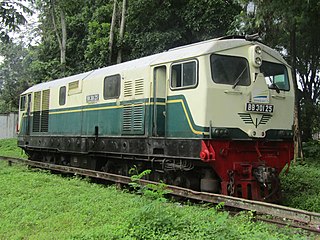
The BB301 is a class of 50 diesel-hydraulic locomotives built by Krupp and Krauss-Maffei in West Germany for the then Indonesian State Railway (PNKA). The locomotive first entered service in 1964.



